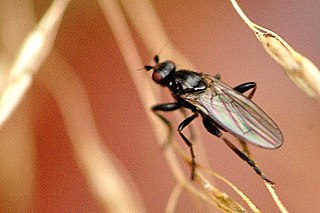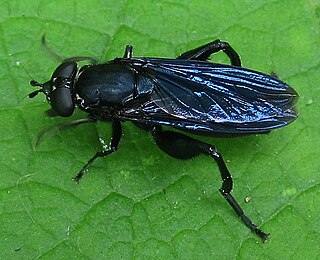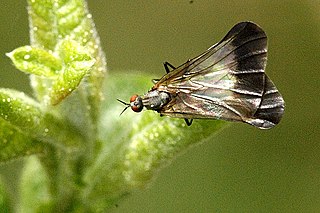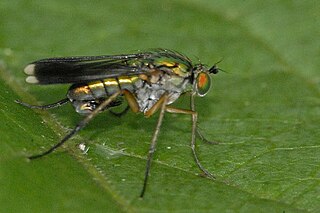
Friedrich Hermann Loew was a German entomologist who specialised in the study of Diptera, an order of insects including flies, mosquitoes, gnats and midges. He described many world species and was the first specialist to work on the Diptera of the United States.

The Ulidiidae or picture-winged flies are a large and diverse cosmopolitan family of flies (Diptera), and as in related families, most species are herbivorous or detritivorous. They are often known as picture-winged flies, along with members of other families in the superfamily Tephritoidea that have patterns of bands or spots on the wings. Some species share with the Tephritidae an unusual elongated posteroapical projection of the anal cell in the wing, but can be differentiated by the smoothly curving subcostal vein. Two species, Tetanops myopaeformis and Euxesta stigmatias, are agricultural pests.

Sphaeroceridae are a family of true flies in the order Diptera, often called small dung flies, lesser dung flies or lesser corpse flies due to their saprophagous habits. They belong to the typical fly suborder Brachycera as can be seen by their short antennae, and more precisely they are members of the section Schizophora. There are over 1,300 species and about 125 genera accepted as valid today, but new taxa are still being described.

The Chamaemyiidae are a small family of acalyptrate flies with less than 200 species described worldwide. The larvae of these small flies are active and predatory and are often used for biological control of aphids, scale insects, and similar pests. Chamaemyiid fossils are poorly represented in amber deposits, but a few examples are known from the Eocene epoch onwards.

Trupanea is a genus of tephritid or fruit flies in the family Tephritidae.

Chalcosyrphus is a genus of hoverflies in the subfamily Eristalinae. Many species exhibit some degree of mimicry of various sawflies and other hymenopterans and are often brightly coloured or metallic in hue. The adults are similar in structure and behavior to the related genus Xylota but differ in larval morphology. They can be found throughout Europe, Asia, and North America and seem to prefer damper, boggy habitats. The larvae are saproxylic feeders in rotten wood in these habitats.

Empis is a genus of dance fly, in the fly family Empididae. It contains the following subgenera and species:

Rhamphomyia is a genus of dance flies, in the fly family Empididae.

Platystoma is a genus of flies (Diptera) belonging to the family Platystomatidae.

Diaphorinae is a subfamily of flies in the family Dolichopodidae.

Poecilobothrus is a genus of flies in the family Dolichopodidae.

Limosininae is a subfamily of flies belonging to the family Sphaeroceridae, the lesser dung flies.
Phaeobalia is a genus of flies in the family Empididae.
Wiedemannia is a genus of flies in the family Empididae.
Hilarempis is a genus of flies in the family Empididae.
Empis basalis is a species of fly in the family Empididae. It is included in the subgenus Euempis. It is found in the Palearctic.
Empis eversmanni is a species of fly in the family Empididae. It is included in the subgenus Polyblepharis. It is found in the Palearctic.
Melametopia is a genus of flies in the family Chamaemyiidae.











